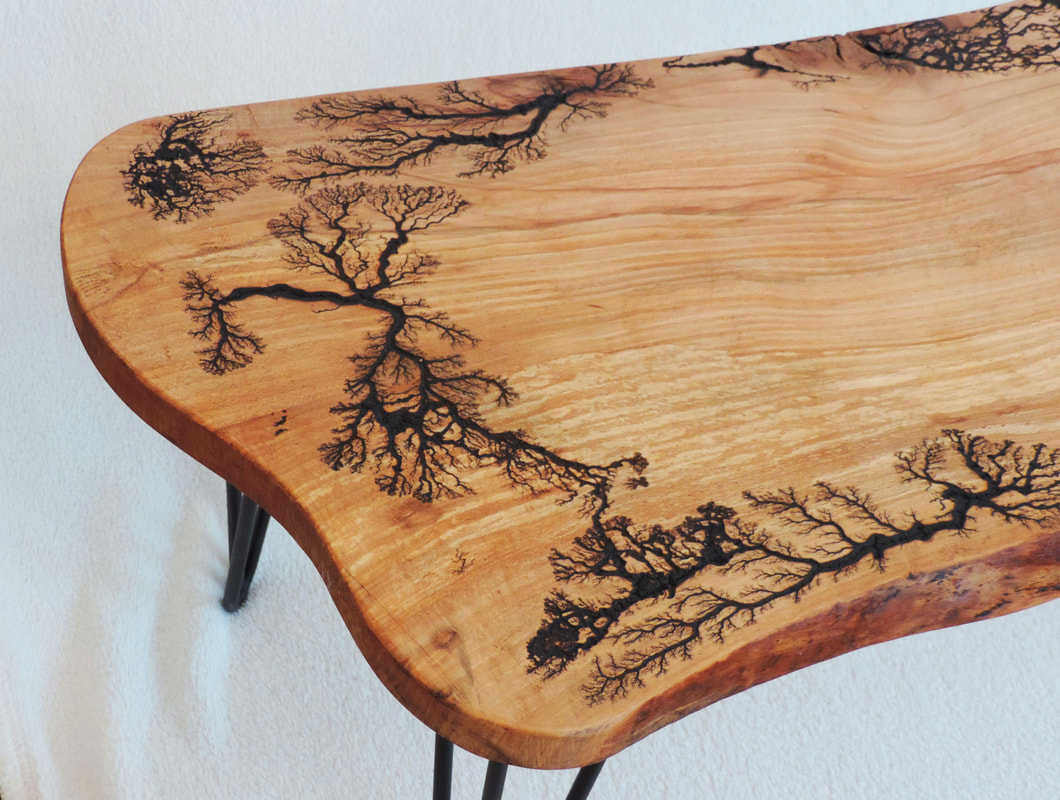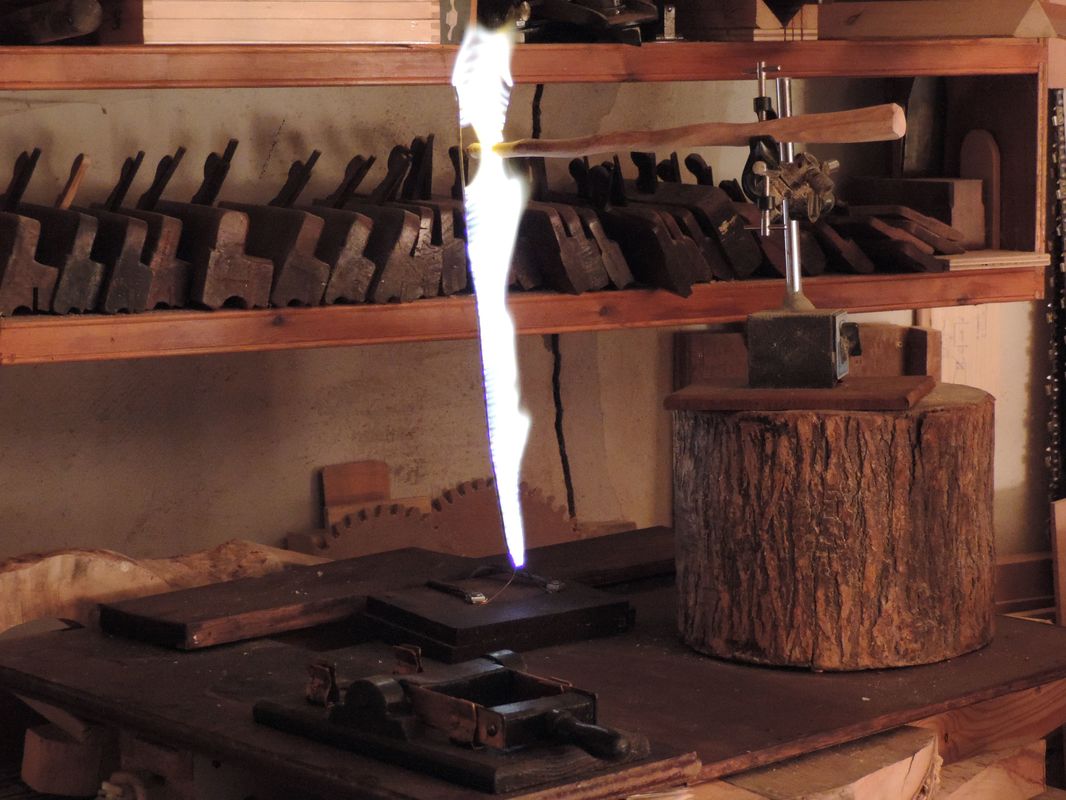|
This week I’ve been making serving trays, in line with the “beautiful, useful or preferably both” motto. The thing about trays these days is they’ve become more useful than beautiful - boring plastic utilitarian things that just don’t do it aesthetically. So I thought it was time to remedy matters.  I wanted something that was simple but nice to hold, with some subtle curves to draw in the eye and, since trays spend most of their life propped up against a wall, an interesting design.
 The base is black walnut veneer and the design inlaid with beech shaded with hot sand. This is proper hands-on traditional veneer inlay - none of your soul-less computer-generated laser engraving here. This is put in a vacuum press and uses the weight of the atmosphere to achieve about 1 1/2 tons of pressure. Quite impressive. The design is a Celtic Triquetra or Trinity Knot, one of the oldest Celtic symbols, which has several meanings showing our inter-connectedness to life, nature and each other:- The Holy Trinity; Body, Mind and Spirit; Earth, Sea and Sky; Maiden, Mother, Crone; etc. But the one I like the best is the three promises to your loved one: Love, Honour and Protect. And as such is traditionally given as gift at engagements, weddings and anniversaries. So instead of serving tea on a so-so plastic tray, you can present your offerings on something quite special, that’s nice to look at even when it’s not in use.
* * * * * * These are available to order and I can inlay custom designs/ logos within reason. Contact me to discuss.
0 Comments
This is a bit old school, well ancient really, but handy to know in a fix.
Before set-squares were checked to the nearest nanometre and proper saws had a wooden handle without a plastic square edge, craftsmen knew several ways to make sure their cut, and their work, was at right angles. The above technique employs a simple compass, which can be made from anything - even a bit of string- and a straight edge to draw a line. When you see it, it's stunningly simple, if not obvious, and can be scaled to any proportions - handy on a building site too.. Indeed, most of the greatest historical buildings in the world, from the pyramids to Chartres Cathedral and the like, were set out and built using simple techniques such as this. So, if you can't find your try-square or your laser turning thingy-ma-bob, it's fine. Try this - you'll be in good company. It appears my Instagram account has been hacked - so I shut it down.
I've been that busy with other stuff I didn't notice that I had automatically started following over 1000 people - and some of them were not my cup of tea. It could either be a password hack or an app with unauthorised access. Either way its under review. Will post more pics on the website shortly. Sorry for any inconvenience. My granny said you should always save your jam jars. Apart from making jam and historically getting you into Pitlochry Picture House, they have a multitude of uses. I use them for mixing and saving polishes, dyes, waxes and just about anything else. But the most useful jar is this one… They say that if Nikola Tesla had been allowed to continue his research, we would be travelling between the stars by now.
Unfortunately the promise of cheap energy was too much for the power and oil companies of the time - nothing much changes there then. He did, however leave us a legacy of amazing High Voltage research and experiments that have inspired people ever since. This is a small coffee table made from a slab of flame beech and treated with high voltage creating beautiful figuring as the current burns into the wood and creeps its way along the grain. It is totally unique. I’m calling it the “Tesla Table” - I’m sure he would have approved. Dimensions - 38” L x 15”W x 15” H This is for sale - so contact me if you’re interested. [email protected] I've just finished making some pendulums for an order and find them quite fascinating.
Dowsers use them to find out all different stuff, but as a woodworker I think they're cool. You can get one HERE These ones are made from some very old beech found up here in the Highlands. The spalted ones are a long, thin type of pendulum known as "Radionic" which is supposed to be particularly good. Some people get into dowsing using rods whilst others use a pendulum - it's whatever works for you. Last week I held a very successful course on "How to Build your Own Geodome" with a great bunch of participants, at beautiful Newbold House.
As you can see, the juxtaposition of the new and the old turned out very interesting. These domes are immensely strong for their size and make extremely economical use of materials and are easy to build- when you know how. They are particularly suited for greenhouses and the tunnel type domes are a very strong alternative to polytunnels. Although you can cover them with sheeting to make a utility building, glamping hut or anything you want. The one pictured can be connected in an array - so you can connect several of them together if you want to expand. I can supply them in kits that you cover yourself (not difficult) like the picture or ready to assemble fully complete domes. I can also provide the base and put it up for you. All different sizes, shapes and coverings available. Contact me if you're interested. I sometimes get asked: "So, what's the secret to making a Real Magic wand?" Well, it's quite simple, and like all good magic - it's not a secret. You pick the right wood, from the right tree. You shape it, just so. Then you have to energise it. If you don't, it won't work. This isn't as woo-woo as you might think. I do it using a 'Jacob's Ladder' (stairway to heaven and all that). It's a bit of Steampunk High Voltage kit that I made in the lab. Sometimes it scorches; sometimes it doesn't. Explained better in the video. The next question is invariably: " So, how do you DO real magic then?" - Duh... With a real magic wand....  It came to the point where I had to make a new shave-horse. This is a wooden work holding device that is, at the same time, simple, clever and very efficient. No surprise then, that the basic design has been around for centuries. It holds all shapes of stock to be worked with ease and is almost a pre-requisite of green woodworking, but it's also just so handy for shaping stuff fast. The itinerant chair makers of the great beech forests - the original Bodgers - would use these to fashion chair legs and spindles, whilst the wheelwrights would sit on one of these as they shaved the wooden spokes for wagon wheels - with a spokeshave, of course. The only thing wrong with them was that they were usually great brutes of things that took up a lot of valuable space. This one is my deluxe version, a hybrid (and simplification) of some of the better designs out there. Its got an adjustable comfy seat, adjustable working height and head angle and most importantly, it folds down for easy storage. This is a very sturdy and able horse. If you want one send me a message. I also might do a course on “Build your own foldable shave-horse to take home" (budget version), if there’s enough demand - again send me a message if you’re interested. This is a real chainsaw, none of your fancy anti-vibration, heated handles, safety this and low noise that.
All you need to operate this is a pair of tackety boots and a pipe - and of course a high degree of skill. I'm sharpening it up with a new rip chain for making slabs - up to 3 feet - this coming season. Made in 1965, this Stihl 07 S is, at 74cc, quite simply a monster. But it chews through hardwood like nothing else and is still going strong. They really don't make them like they used to. |
The BlogMy perspective on woodworking by hand, observations, experiments and other random madness. Latest
June 2018
|
T: 01309 671504 M: 07513903182 E: [email protected] |
© COPYRIGHT 2018. ALL RIGHTS RESERVED.
|



















 RSS Feed
RSS Feed